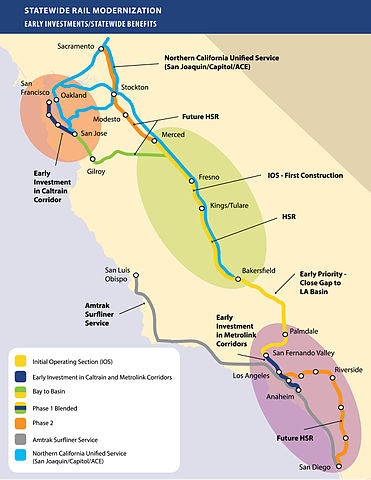June 16, 2017 will mark two years since construction on California’s planned total 800-mile high-speed rail system got underway. It could be year 2033 when the entire project is completed or 18 years from start to finish.
Progress-wise, in getting to where the program is now, wasn’t easy. High-speed rail finally made it as a ballot measure (Proposition 1A) in 2008. The “Safe, Reliable High-Speed Passenger Train Bond Act for the 21st Century,” (as it is known) passed by a slim margin: basically, 52 percent of the vote among the California electorate who voted on the measure.
Then there were delays, multiple delays, in fact, pushing back construction getting started. But, eventually work did begin: first with utility relocation work, followed by utility relocation and demolition work going on simultaneously, before finally on June 16, 2015 real construction activity actually beginning, exclusively in a non-descript location in Madera County at, principally, the Fresno River. The viaduct spanning Raymond Road, the Fresno River and State Route (SR) 145 was begun. An official groundbreaking (rail-signing ceremony, actually), meanwhile, preceded that by several months on Jan. 6th in downtown Fresno. It was a momentous event and occasion; not unlike the joining of transcontinental rails of the Central Pacific and Union Pacific railroads on May 10, 1869 in Promontory, Utah.
Suffice it to say, it has been a long, arduous road and hard-fought fight, just to get the endeavor to the place and state it is today. Opposing forces have been nothing short of relentless in their efforts to bring the project to a screeching halt.
One lawsuit after another filed in the hopes of seeing the project permanently sidelined, all such suits ending with seemingly little success, yet the legal actions aimed at keeping construction progress from advancing any further kept right on coming. Another: yet to be decided, still.
With multiple individuals, I have had many high-speed rail discussions.
I’ve chatted with folks who’ve ridden fast trains in foreign and far-off lands. While all have had favorable experiences riding, only one supports the California plan, program.
One of the arguments against – perhaps the main one – revolves around cost. Typical responses are that state promoters originally pitched one dollar figure, then another, and another, until reaching the figure that it is presently – $64 billion.

Others, still, argue the system won’t make money, that it will need public subsidy and that the money to allow the system to get built won’t ever materialize. All of it, hearsay – no one could ever know this absolutely.
My response: We will never know if we don’t build.
Though, there are no guarantees, one thing is for sure: High-speed rail systems around the world are each and every one successful.
All about the journey … for now
The journey that is California high-speed rail has certainly been an interesting one – no question.
That said, where, exactly, is California’s fast-train program now?!
There are seven main construction-activity efforts in progress. North to south, these are :
- Raymond Road/Fresno River/SR 145 viaduct (nearing completion)
- Cottonwood Creek viaduct (well underway)
- San Joaquin River viaduct and pergola (well underway)
- SR 99 relocation effort between Ashlan and Clinton avenues (about midway through the construction work)
- SR 180/Dry Creek Canal/Union Pacific Railroad wye trench project (well underway)
- Tuolumne Street overcrossing (nearing completion)
- SR 99/Cedar Avenue/North Avenue overcrossing (well underway)
Besides these, for 32 miles total, there is much right-of-way clearing work ongoing in both Madera and Fresno counties in the section known as Construction Package One (CP-1), not to mention ongoing overcrossing work at several locations in Madera County – to Fresno County’s north. All of it very much in evidence.
Food for thought
Chew on this: If the high-speed rail project isn’t built to completion by the date when full build-out of the railway is projected, in building roadways, airport runways and added gates, just to be able to handle California’s anticipated population growth, meet our travel requirements and that of visitors from elsewhere in the Americas as well as those visiting from abroad, such airway- and roadway-based transportation infrastructure is estimated to cost at least one-and-a-half times what it would cost to build high-speed rail – handily.
And this: Considering the negative environmental damage both airway and roadway traffic inflict, high-speed rail is, far and away, the better value.
And, on that note and this one, “California [high-speed-rail service] here we come!”
For more about California high-speed rail progress and the project, visit the California High-Speed Rail Authority Web site here.
Note
Correction: It was originally stated that California high-speed rail groundbreaking took place on June 6th in 2015. The article has been updated and now includes the correct date.
Image above: California High-Speed Rail Authority
– Alan Kandel
How is the air quality affected by this activity and its aftermath?
Air quality in the area is affected, obviously. However, compared to what is typical in highway building, highway building activity is by far the more environmentally harmful of the two, this, of course, based on the type of equipment being used in the construction process. Motorized equipment used in the construction of this high-speed train system, for the most part, meets stringent Tier 4 emissions specifications – the cleanest-burning going. I believe you would be hard-pressed to find this to be the case with comparable (that would be a stretch) highway building.
Along the same lines, you may want to read the article: “For National Transportation Week, road, rail, air compared,” corresponding link here: http://alankandel.scienceblog.com/2014/05/15/for-national-transportation-week-road-rail-air-compared
I hope this helps.
Dear Alan,
You do realize you are an idiot. Right?
Lou
Alan,
I’m very much against the HSR but you’re the idiot here.